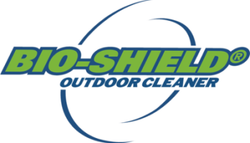How To Clean Limestone, Sandstone and Bluestone
Cleaning Limestone, Sandstone and Bluestone with Bio-Shield®
Including cleaning of:
- Sandstone and Travertine Walls and Pavers
- Limestone Walls and Pavers
- Marble Walls, Pavers and Statues
- Bluestone and Granite Walls and Pavers
- Slate
Bio-Shield® vs Pressure Cleaning - Which one is better?
Black and discolored stone is unsightly, hiding the attractive natural finish of these high quality building materials.
The black discoloration that looks like dirt is actually an algae. This algae makes paving slippery when wet and will
damage a softer stone surface over time. Pressure cleaning to remove black algae and moss will create damage by stripping away the soft surface of limestones and sandstones, leaving a rougher, more porous surface that will trap dirt and promote excessive black algae and moss regrowth.
The softer sandstone and limestones should not be pressure cleaned to remove algae as it will damage the surface.
Pressure cleaning is expensive and consumes large amounts of water but does not kill algae or moss so it will begin to regrow immediately
The easiest and most cost effective method for cleaning and maintaining natural stone surfaces is the application of Bio-Shield.
Why choose Bio-Shield® for your D.I.Y Stone Cleaning?
Application of Bio-Shield takes a fraction of the time that pressure cleaning does, will not damage the surface and will keep the stone clean for longer. Regular maintenance applications of Bio-Shield every 12 to 24 months, at the first sign of re-growths will effect a rapid clean up and keep the surface clean again for an extended period.



Bio-Shield® Application Instructions
Preparation
For a successful DIY job, preparation is the key. Following these simple steps will ensure an effective clean up and a professional looking job.
Remove loose debris, tree leaves, dirt etc, from the surface.
Remove pets toys and feeding bowls from the area to be treated.
Keep children and pets off the treated surface until it dries.
Do not feed pets on the treated surface until the surface has been flushed by rain.
The surface can be either dry or damp but ensure that any moss growths has dried out after rain- To check this, squeeze a large clump to see if water comes out - no water, its OK to spray.
Check the weather forecast, or rain radar - the treated surface should stay dry for 4 hours.
Air temperature above 10 degrees C° will help to accelerate biocidal action.
Premix the Bio-Shield® 1 part to 20 parts water in a pressure sprayer
If using the Jet-Stream applicator follow the instructions on the link for its use and set-up.
Bio-Shield Mixing Ratios - for Pressure Sprayers
| Clean Water | Bio-Shield Concentrate | Diluted Bio-Shield |
|---|---|---|
| 1 Litre | 50 ml | 1.05 Litres |
| 10 Litres | 500 ml | 10.5 Litres |
| 15 Litres | 750 ml | 15.75 Litres |
| 20 Litres | 1 Litre | 21 Litres |
CAUTION - Bio-Shield is OK to use on house walls and windows. If the surface is not exposed to rain e.g. under the eaves or high on the wall, it will need to be washed down to assist removal of the Bio-Shield and dead growths.
Care should be taken when using Bio-Shield around old powder coated aluminum window frames, where the powder coating is oxidised.
Most types of outdoor cleaners will leave marks on the darker colours that have oxidised (aged).
Application
Application is best done on an overcast day at any time of the year, or early morning / late afternoon in summer if a warm sunny day is forecast.
This slows evaporation and speeds the treatment process.
Application on a damp surface is OK as long as the surface fully dries after the Bio-Shield has been applied.
Fill your sprayer with the premixed Bio-Shield solution and pump it up to pressure.
If using the Jet-Stream Applicator, follow the set-up instructions on the bottle label or watch the instructional video. Apply in slow even strokes allowing the following stroke to overlap the previous stroke by 50% to ensure even and complete coverage.
Planters, steps, railings, either glass or timber can also be safely treated with Bio-Shield.
Limestones and Sandstone will temporarily change to an orange brown colour as the Bio-Shield reacts with the algae. This colour change will fade over 24 to 48 hours.
Thick moss must be allowed to dry out after application and will change colour to brown over a few days, indicating it is dead.
Bio-Shield does not kill plants, grass or trees, but may cause minor leaf damage (spots) on delicate plants. Hose off any affected plants after the application to prevent any damage.
Basalt and other hard stone will need to 3 to 4 hours of dry weather after application for the Bio-Shield to be effective.
Clean Up
Bio-Shield acts to kill the moss, algae and lichens on the surface over the next 2 to 4 hours. After a few days there will be visible color changes to the dead moss and any lichen growths. Black algae does not change color. The treated surface will begin to clean up after 3 months as the dead growths begin a natural breakdown to be washed away by rain. The clean up will continue over 12 months providing the treated surface is exposed to rainfall.
Maintenance
It is best to reapply Bio-Shield® at the first signs of re-growth. Typically this will be every 12 months for a ground contact surface as it stays wet over winter. Best practice would be to respray the surface just as the regrowth's become visible again.
On clean surface with light regrowth such as green algae, the application will be easier, faster and use less diluted solution; any new growths will die off and the surface will clean up quickly.
Once the surface is clean, Bio-Shield® will give optimal results with regular treatments.
